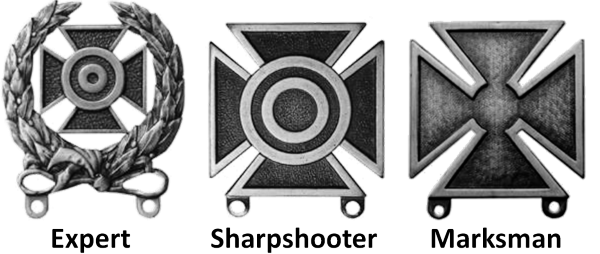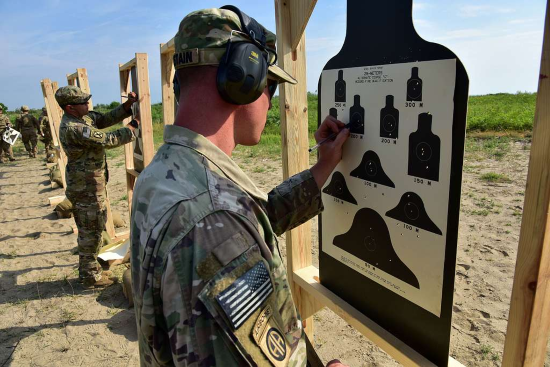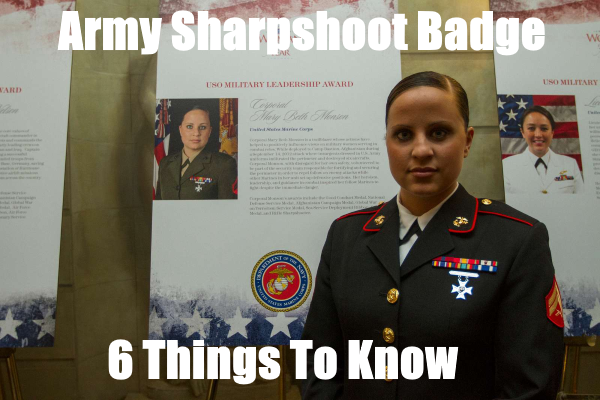The Army Sharpshooter Badge is an important distinction of the service branch.
The badge is one of the marksmanship awards that Army personnel can earn.
However, the award is not permanent, and so soldiers must requalify for the military honor each year.
There are several important things to learn regarding the U.S. Army Sharpshooter Weapons Qualification Badge.
Discover the 6 most important, below.
Related Article – Army Service Ribbon (ASR): 5 Things To Know
Army Sharpshooter Badge: 6 Things to Know

There are numerous military awards and special recognition.
These types of military achievements range from completing basic training (like the Army Service Ribbon) to badges reflective of marksmanship.
As a result, the United States Army issues the Sharpshooter Weapons Qualification Badge.
Army marksmanship badges are traditionally granted to soldiers upon completing the Army Weapons Qualification Course.
Generally, the service award is presented in 3 grades: Marksman, Sharpshooter, and Expert.
There are several important aspects to consider regarding the Army Sharpshooter Badge, including:
- Purpose
- History
- Design
- Eligibility / Requirements
- Army Weapons Qualification Course
- Uniform Placement
Learn more about each aspect of the Army Sharpshooter Badge, below:
#1. Purpose of Army Sharpshooter Badge
The U.S. Army Sharpshooter Weapons Qualification Badge is a distinction of the service branch.
In other words, it’s awarded to service members after they complete the Army Weapons Qualification Course with a high level of skill.
The weapons course is part of Army Basic Combat Training (BCT) and is designed to test marksmanship skills.
For this reason, the U.S. Army awards marksmanship in 3 grades:
- Marksman
- Sharpshooter
- Expert
“Marksman” is the status of a basic or entry-level marksman.
Then, the “Expert” status is awarded to those that test in the highest quadrant.
Meanwhile, “Sharpshooter” is an honorable status reserved for soldiers that fall somewhere in the middle.
Those that successfully complete Army rifle qualification receive some type of honor.
Regardless, the military award is not permanent.
Thus, soldiers must requalify for the Army award each year (see: Army Sharpshooter Badge Eligibility & Requirements).
#2. History
The Army Sharpshooter Badge, like other marksmanship honors in the service branch, has a long history.
In fact, the United States Army has been awarding marksmanship qualification badges since the late 19th century.
The marksmanship badges influenced other military branches to adopt similar awards, including the U.S. Navy and Marine Corps in the early 20th century.
Moreover, there are U.S. civilian equivalents to the Army Sharpshooter Badge, including the Corporation for the Promotion of Rifle Practice and Firearm Safety (CPRPFS).
The National Rifle Association (NRA) has promoted civilian marksmanship awards since 1903.
Nevertheless, it all began with the U.S. Army.
Today, the service branch awards marksmanship distinctions annually to active duty personnel, U.S. Army uniformed civilian guards, and foreign military personnel.
#3. Design

The Army Sharpshooter Badge features a unique, intricate design.
The shape of the medal is comparable to a cross with equal length on each corner.
Meanwhile, two circles encompass the middle of the medal.
Suspended from the Army Sharpshooter Badge are qualifications bars.
These qualification bars indicate the specific weapon(s) the soldier qualified for the status of “sharpshooter”.
The only stipulation is that a maximum of 3 marksmanship badges are authorized to wear at one time on the uniform.
Furthermore, each badge may only present 3 qualification bars (see: Army Sharpshooter Badge Uniform Placement).
The United States Army currently authorizes the following Weapon Qualification Clasps:
- Rifle
- Pistol
- AA Artillery
- Automatic Rifle
- Machine Gun
- Submachine Gun
- Carbine
- Field Artillery
- Tank Weapons
- Flamethrower
- Rocket Launcher
- Grenade
- Missile
- Mortar
Additionally, the Army Sharpshooter Badge may include specialized types of rifles and pistols, such as:
- Recoilless Rifle
- Small Bore Rifle
- Small Bore Pistol
Furthermore, the U.S. Army still recognizes marksmanship achievements with a bayonet and aero-weapons.
The level at which a service member qualifies depends on several factors (more information, below).
Related Article – Army Commendation Medal (ARCOM): 8 Things To Know
#4. Eligibility / Requirements
There are several important requirements to note regarding eligibility for the Army Sharpshooter Badge.
First, the Army Weapons Qualification Badge is only issued upon completion of the weapons qualification course.
Secondly, to earn “Sharpshooter” status, soldiers must earn a score of between 30-35 points (out of 40 rounds).
Thus, the margin for error is slim and even less for soldiers seeking the qualification of “expert.”
The weapons qualification course awards 1 point for hitting any point on the target.
Recruits must A) fire 20 rounds from a supported position (prone or in a foxhole), B) and 20 rounds from a couple of unsupported positions (kneeling and prone).
It’s important to remember that Army marksmanship qualification badges are not permanent awards.
Therefore, soldiers must requalify for the marksmanship award every 12 months.
If the service member cannot meet the status of “Sharpshooter” with the same weapon, he or she is disqualified from the badge.
Then, 12 months later, the soldier can attempt to requalify for the status of “Sharpshooter.”
The level at which one qualifies may vary depending on the weapon, as well as the firing range and course of fire.
For example, the qualifications for a pistol differ from those for a rifle.
Notwithstanding, there are some general requirements, such as the ability to fire from multiple positions.
The annual weapons qualification after basic training now also tests a soldier in certain unique situations (i.e. chemical, biological, radiological, and nuclear events) or when firing a weapon at night.
Recently, the U.S. Army changed some of its standards regarding the marksmanship course.
Accordingly, service members that fail to meet the guidelines of “Sharpshooter” status may apply for the Marksmanship Master Training Course.
The course lasts 5 weeks and is designed for Army NCOs to train as sharpshooters before passing those skills to enlisted personnel.
#5. Army Weapons Qualification Course
The Army weapons qualification course is an important step in completing basic training.
For this reason, service members spend a portion of boot camp learning how to become marksmen and markswomen.
In general, Army marksmanship training consists of a few different phases.
All in all, the training lasts approximately 2-3 weeks, depending on the qualification.
The United States Army awards marksmanship honors for various weapons.
As a result, the standards may vary depending on the weapon.
Nonetheless, “Sharpshooter” status is an important distinction that places the soldier at a higher rank than “Marksman.”
However, it’s also below the rank of “Expert,” which is the highest standard a soldier can receive in the course.
Be that as it may, “Sharpshooter” is still an impressive honor considering individuals must hit between 30-35 targets (out of 40).
The purpose of the marksmanship course is to test a soldier in various conditions.
For this reason, the soldier fires rounds at a target from a specific distance.
Moreover, these include the challenges of firing from a “supported” and “unsupported” positions.
#6. Army Sharpshooter Badge Uniform Placement
There are several important considerations when placing an Army Sharpshooter Badge on the military uniform.
In general, service members must adhere to specific guidelines, including the correct placement of military awards and honors.
Thus, Army personnel are only authorized to wear a maximum of 3 Army Marksmanship Qualification Badges.
It may not reflect the total number of marksmanship awards acquired, but that’s the guidelines of the U.S. Army.
Furthermore, soldiers must verify that they have no more than 3 Army Weapon Qualification Clasps, per badge.
More importantly, the service award is presented to both Army officers and enlisted personnel.
However, per tradition, only enlisted members are expected to wear the badges on their service uniforms. This policy may vary depending on the unit commander.
The Army Sharpshooter Badge is not a permanent award.
Thus, Army personnel must requalify every 12 months for the same award.
Those who require a different level/status must replace the former badge with the new reflection of marksmanship status.
Related Article – USMC Rifle Qualification
Conclusion
Presently, the United States Army and Marine Corps are the only service branches that award marksmanship qualification badges.
The Army badge is the original distinction that dates back to the late 18th century.
Today, as was the case 200 years ago, Army personnel receive marksmanship awards in 3 different categories.
“Expert” is the highest honor, while “Sharpshooter” is a status directly below it.
“Sharpshooter” ranks higher than the level “Marksman” in terms of badges.
The Army Sharpshooter Badge is presented for various weapons, including rifles and pistols.
Learn more about other Army awards and honors, including the Army Achievement Medal.
Featured Image Source – www.GetArchive.net
- Replacing Dog Tags: 6 Things You Need to Know - June 28, 2024
- Navy OAR Test Study Guide - June 24, 2024
- 10 Best Sniper Movies of all Time - June 20, 2024
Originally posted on February 27, 2023 @ 11:04 pm
Affiliate Disclosure: This post may contain affiliate links. If you click and purchase, I may receive a small commission at no extra cost to you. I only recommend products I have personally vetted. Learn more.

